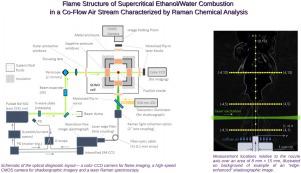The Journal of Supercritical Fluids ( IF 3.4 ) Pub Date : 2020-08-23 , DOI: 10.1016/j.supflu.2020.104995 Jun J. Kojima , Uday G. Hegde , Daniel J. Gotti , Michael C. Hicks

|
The thermochemical properties of the ethanol hydrothermal flame (30%-v ethanol-water solution), established in air co-flow under supercritical water conditions, are measured by a quantitative Raman diagnostic technique. The unique spectroscopic features of the chemical compounds are revealed to aid understanding of the fuel decomposition and oxidation process in supercritical phase. A point-wise fiber-optic probe is designed to resolve the needle-like thin flame and identify the spatial profiles – across the flame thickness and over the height of the visible flame – of the combustion species at different fuel/air ratios and airflow rates. An attempt is made to analyze the steep thermal gradients in the primary reaction zone near the fuel nozzle by estimating thermodynamic temperatures from the measured fluid density. The test cell was held at conditions above the critical point of water, at a nominal pressure of 25 MPa and a nominal temperature of 723 K (450 °C). The flames were over ventilated with an excess air:fuel ratio between two and five times stoichiometric. Depending upon the air:fuel ratio non-sooting blue flames or yellow sooting flames are observed. The results of the Raman diagnostic provide temperature and species profiles that will prove useful for validating numerical models using an idealized laboratory hydrothermal flame. The Raman diagnostic results are augmented with imaging from two orthogonal camera views: a backlit shadow-graphic image of the co-flow jet and a color image of the flame.
中文翻译:

用拉曼化学分析表征并流气流中超临界乙醇/水燃烧的火焰结构
通过定量拉曼诊断技术测量在超临界水条件下空气共流中建立的乙醇热液火焰(30%-v乙醇-水溶液)的热化学性质。揭示了化合物的独特光谱特征,以帮助理解超临界相中的燃料分解和氧化过程。一种点状光纤探头旨在解决针状稀薄火焰并识别不同燃料/空气比和气流速率下燃烧物种的空间分布-跨火焰厚度和可见火焰高度- 。试图通过根据测得的流体密度估算热力学温度来分析燃料喷嘴附近的主反应区中陡峭的热梯度。将测试池保持在高于水的临界点的条件下,额定压力为25 MPa,额定温度为723 K(450°C)。过量的空气:燃料比为化学计量的2至5倍,使火焰过度通风。取决于空气:燃料比,观察到不发烟的蓝色火焰或发烟的黄色烟灰。拉曼诊断的结果提供了温度和物种分布图,对于使用理想的实验室热液火焰验证数值模型非常有用。通过两个正交相机视图的成像增强了拉曼诊断结果:同流射流的背光阴影图形图像和火焰的彩色图像。过量的空气:燃料比为化学计量的2至5倍,使火焰过度通风。取决于空气:燃料比,观察到不发烟的蓝色火焰或发烟的黄色烟灰。拉曼诊断的结果提供了温度和物种分布图,对于使用理想的实验室热液火焰验证数值模型非常有用。通过两个正交相机视图的成像增强了拉曼诊断结果:同流射流的背光阴影图形图像和火焰的彩色图像。过量的空气:燃料比为化学计量的2至5倍,使火焰过度通风。取决于空气:燃料比,观察到不发烟的蓝色火焰或发烟的黄色烟灰。拉曼诊断的结果提供了温度和物种分布图,对于使用理想的实验室热液火焰验证数值模型非常有用。通过两个正交相机视图的成像增强了拉曼诊断结果:同流射流的背光阴影图形图像和火焰的彩色图像。拉曼诊断的结果提供了温度和物种分布图,对于使用理想的实验室热液火焰验证数值模型非常有用。通过两个正交相机视图的成像增强了拉曼诊断结果:同流射流的背光阴影图形图像和火焰的彩色图像。拉曼诊断的结果提供了温度和物种分布图,对于使用理想的实验室热液火焰验证数值模型非常有用。通过两个正交相机视图的成像增强了拉曼诊断结果:同流射流的背光阴影图形图像和火焰的彩色图像。











































 京公网安备 11010802027423号
京公网安备 11010802027423号